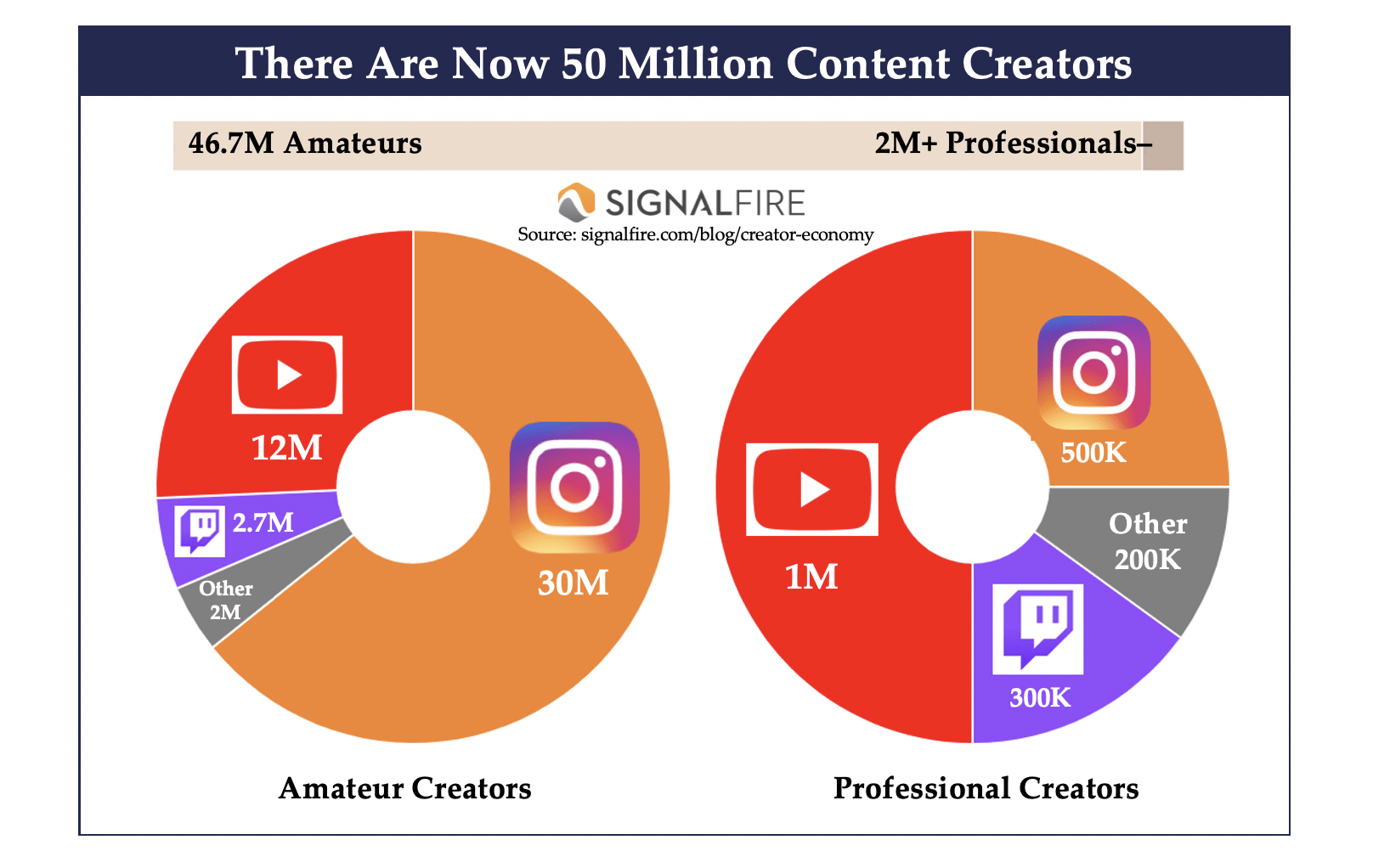Over the past few years, the creator economy has seen significant growth due to the rise of social media and the increasing popularity of content creation as a means of income. Creators have the ability to reach a global audience through platforms such as YouTube, TikTok, and Instagram, and monetize their content through advertising, sponsorships, and merchandise sales.
How big is the creator economy?
It is difficult to determine the exact size of the creator economy, as it is a rapidly evolving and dynamic industry. However, it is estimated that the global creative economy, which includes areas such as music, visual arts, and literature, is valued at over $2 trillion. The creator economy specifically, which encompasses creators such as content creators, influencers, and YouTubers, is a subset of this larger creative economy.
As more and more creators enter the market and the demand for unique, high-quality content continues to grow, it is likely that the creator economy will continue to expand. In fact, some projections suggest that the creator economy could reach $15 billion by 2025.
However, it is important to note that the size of the creator economy can be difficult to measure accurately, as it is a rapidly changing and fluid industry. Factors such as changes in technology, platform algorithms, and creator behavior can all impact the size and growth of the creator economy.
Regardless, it is clear that the creator economy is a rapidly growing and dynamic industry with significant potential for revenue growth. As more and more companies begin to realize the value of working with creators and leveraging the creator economy, it is likely that the size of the industry will continue to grow in the coming years.

Source: SignalFire’s Creator Economy Market Map
What is the creator economy?
The creator economy is a term that refers to the growth of individuals and businesses that create, share and sell content, products, and services online. This economy is rapidly growing and is becoming an increasingly important aspect of the global economy. In the last few years, the rise of platforms such as YouTube, Instagram, and TikTok, has given creators an opportunity to reach a global audience and monetize their content in new and innovative ways.
The creator economy is unique in that it is not limited by geographic borders, making it possible for anyone with a smartphone and internet connection to participate. The number of creators, from content creators to digital product developers, has grown significantly and is expected to continue to grow in the coming years. This growth is driven by the increasing number of people who are seeking to supplement their income through online work, and the growing number of businesses that are seeking to tap into the skills and creativity of the creator community.
In the next two years, the creator economy is expected to see continued growth as more and more people turn to online work as a source of income. This growth is also expected to be driven by the increasing demand for niche products and services that can be created and sold online. For example, there is a growing demand for personalized products, such as custom-designed jewelry, clothing, and home decor. This demand is being met by a growing number of creators who specialize in creating these types of products.
The increasing demand for online content and digital products is also driving growth in the creator economy. The increasing popularity of online video content, for example, is expected to continue to drive growth in this area. The rise of new platforms, such as TikTok, which allow users to easily create and share short-form videos, has also contributed to this growth. Additionally, the growing popularity of online gaming and esports is expected to drive growth in the digital product development sector.
Another factor that is expected to drive growth in the creator economy is the increasing importance of online influencers. Influencers are individuals who have a large following on social media and can use this following to promote products and services. As the importance of online influencer marketing continues to grow, it is expected that more businesses will turn to influencer marketing as a way to reach their target audience. This, in turn, is expected to drive growth in the number of creators who specialize in influencer marketing.
The increasing importance of online security is also expected to drive growth in the creator economy. As more and more personal and business information is stored and shared online, the importance of protecting this information is becoming increasingly important. As a result, businesses are expected to increasingly turn to digital product developers to help them create secure digital products and services.
How can companies integrate the creator economy into their strategy?
So, how can companies utilize the creator economy to drive growth? Here are some steps to consider:
-
Partner with creators: One of the most effective ways for companies to tap into the creator economy is to partner with content creators who have a large and engaged following. This could involve working with influencers to promote your brand, sponsoring their content, or collaborating with them on co-branded products. By partnering with creators, companies can reach a large and engaged audience and build brand awareness.
-
Create original content: Companies can also create their own original content and use it to engage with their target audience. This could include creating video tutorials, blog posts, podcasts, and social media posts that showcase your products or services. By creating engaging and informative content, companies can attract new customers and build brand loyalty.
-
Utilize user-generated content: Encouraging customers to create and share their own content can also help companies tap into the creator economy. This could involve creating contests or challenges that incentivize customers to create and share content related to your brand. This user-generated content can then be shared on your social media channels and website, helping to build brand awareness and engage with your target audience.
-
Offer monetization opportunities: Companies can also offer monetization opportunities to creators, such as affiliate programs or revenue sharing arrangements. This allows creators to monetize their content and build a sustainable income stream, while also helping companies drive revenue growth by tapping into the creator economy.
-
Foster a community: Building a community around your brand can also help companies tap into the creator economy. This could involve creating online forums, social media groups, or live events where customers and creators can engage with one another. By fostering a sense of community, companies can build brand loyalty, drive engagement, and ultimately drive revenue growth.
The creator economy presents a unique opportunity for companies to drive revenue growth and build brand awareness. By partnering with creators, creating original content, utilizing user-generated content, offering monetization opportunities, and fostering a sense of community, companies can effectively leverage the creator economy to drive growth.
As the creator economy continues to evolve and grow, companies that are able to effectively utilize this trend will be well positioned for success. The key is to stay ahead of the curve and find new and innovative ways to engage with customers and build brand awareness. With a well-thought-out strategy and a commitment to leveraging the creator economy, companies can drive revenue growth and build a sustainable future.
Who is partnering with creator?
There are a number of companies that are partnering with social media stars to drive growth and reach new audiences. Some of the most notable partnerships in recent years include:
-
Brands and Fashion Retailers: Many fashion retailers and consumer brands are partnering with social media influencers to promote their products and reach new audiences. For example, fashion retailer Forever 21 has worked with a number of popular social media influencers, including Kylie Jenner and Bella Hadid, to promote their clothing lines and drive sales.
-
Beauty and Skincare Companies: Beauty and skincare companies have also been quick to partner with social media influencers, with many of these companies seeing success in driving growth and reaching new audiences. For example, beauty brand Maybelline has partnered with popular beauty influencer James Charles to promote their products and reach new audiences.
-
Technology Companies: Technology companies have also been quick to partner with social media stars, leveraging their popularity and influence to drive growth and reach new audiences. For example, smartphone maker Samsung has partnered with popular social media star PewDiePie to promote their products and reach a younger, tech-savvy audience.
-
Consumer Packaged Goods Companies: Consumer packaged goods companies are also increasingly partnering with social media stars, leveraging their popularity and influence to drive growth and reach new audiences. For example, beverage maker Red Bull has partnered with popular social media star Casey Neistat to promote their energy drinks and reach new audiences.
These partnerships demonstrate the growing importance of the creator economy, and the role that social media stars are playing in driving growth for companies across a range of industries. As social media continues to evolve and become an increasingly important marketing channel, it is likely that more and more companies will look to partner with social media stars to reach new audiences and drive growth.
Keys to a successful creator collab
When partnering with creators, companies need to be mindful of several things to ensure a successful collaboration. Here are some of the things that companies should avoid:
-
Lack of research: It's important to research the creator's audience, style, and brand values before entering into a partnership. This will help ensure that the collaboration is a good fit for both parties.
-
Neglecting contract details: A well-drafted contract is critical to the success of a partnership. Companies should take care to ensure that all details, including payment terms, expectations, and duration of the partnership, are clearly defined in the contract.
-
Overlooking brand alignment: A social media creator's brand values and aesthetic should align with those of the company. If the collaboration feels forced or inauthentic, it will not be successful.
-
Neglecting communication: Communication is key in any partnership, especially in a social media collaboration. Companies should make sure to regularly communicate with the creator and keep them updated on the status of the partnership.
-
Underestimating the importance of authenticity: Authenticity is essential for a successful social media collaboration. Companies should avoid trying to manipulate or control the content that the creator produces, as this can negatively impact the creator's brand and their relationship with their audience.
-
Failing to measure the impact of the collaboration: Companies should regularly measure the impact of the collaboration on their brand and revenue. This information can be used to inform future partnerships and make improvements to the current collaboration.
By avoiding these common pitfalls, companies can increase the chances of a successful collaboration with social media creators and drive growth through their partnerships.
In conclusion, the creator economy is expected to continue to grow in the coming years, driven by the increasing demand for online content, digital products, and services. This growth is expected to be driven by the increasing number of people who are seeking to supplement their income through online work, the growing number of businesses that are seeking to tap into the skills and creativity of the creator community, and the increasing importance of online security. With the continued growth of the creator economy, businesses and individuals who participate in this economy will have many opportunities to create and sell content, products, and services, and to build successful businesses.



